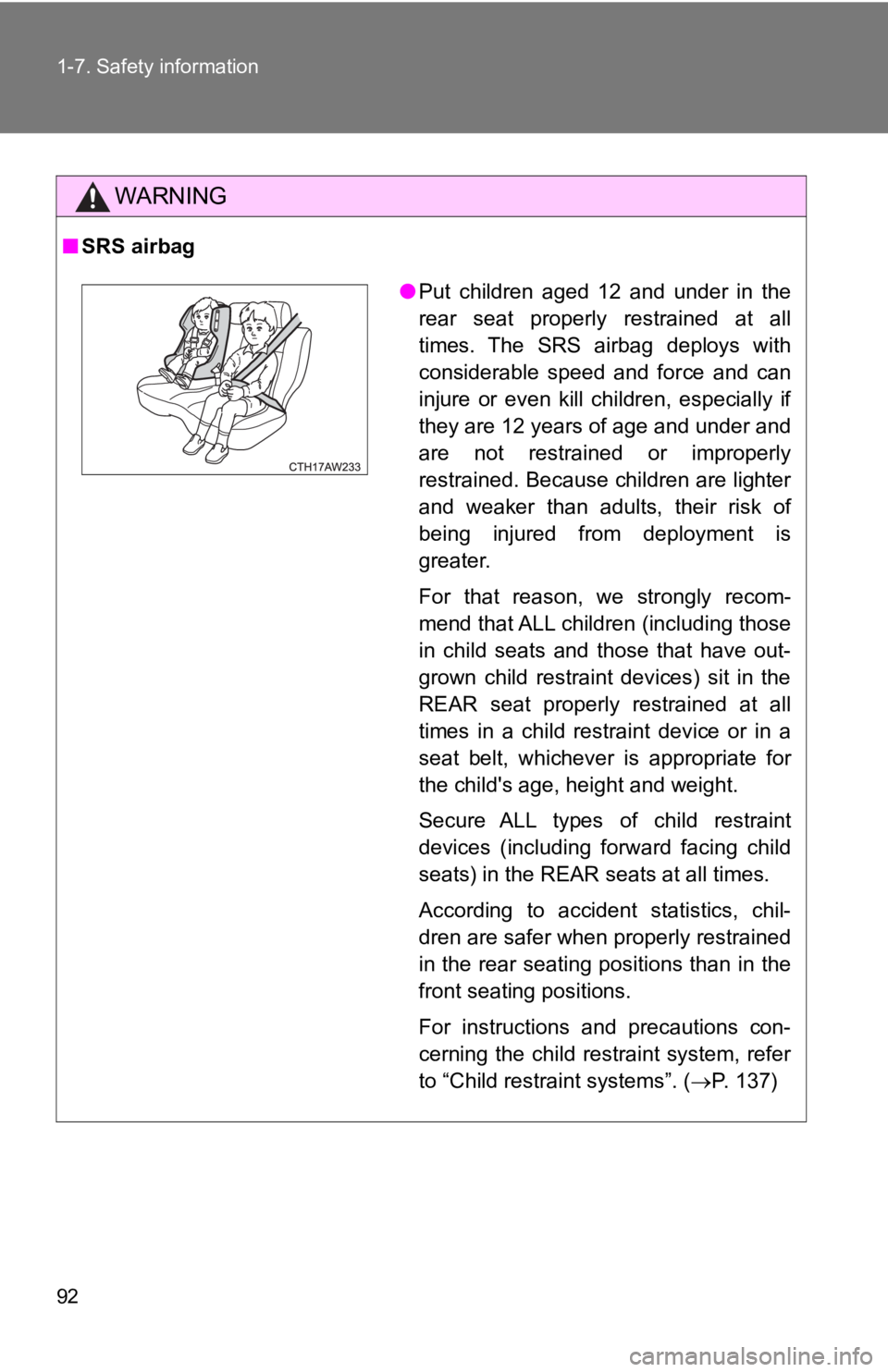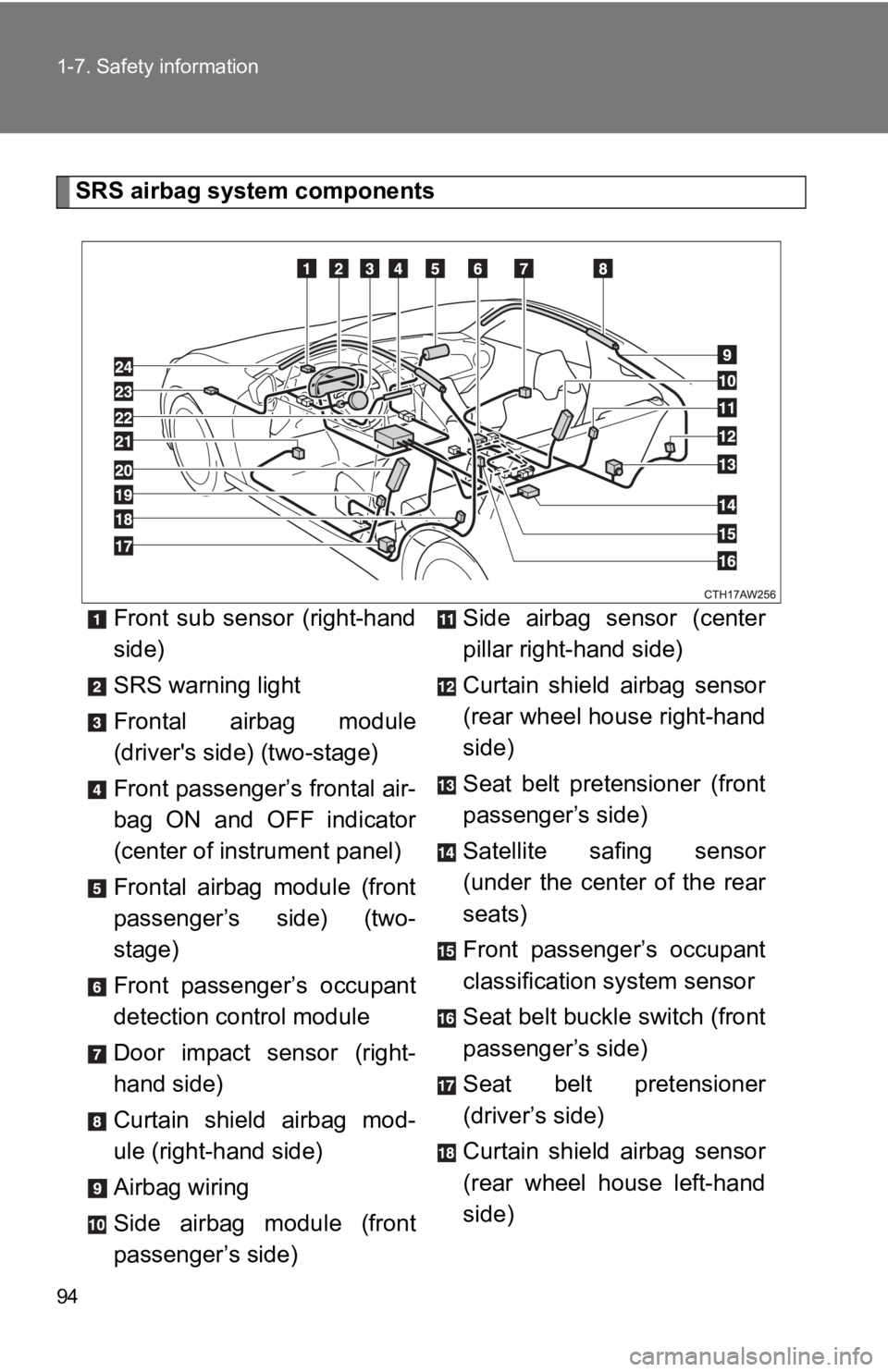TOYOTA GT86 2019 Owners Manual (in English)
Manufacturer: TOYOTA, Model Year: 2019, Model line: GT86, Model: TOYOTA GT86 2019Pages: 532, PDF Size: 7.98 MB
Page 91 of 532

91
1-7. Safety information
1
Before driving
WARNING
■
SRS airbag
●To obtain maximum protection in the event of an accident, the d river and
all passengers in the vehicle should always wear seat belts whe n the vehi-
cle is moving. The SRS airbag is designed only to be a supplement to the
primary protection provided by the seat belt. It does not elimi nate the need
to fasten seat belts. In combination with the seat belts, it of fers the best
combined protection in case of a serious accident.
Not wearing a seat belt increases the chance of severe injury o r death in a
crash even when the vehicle has the SRS airbag.
For instructions and precautions concerning the seat belt syste m, refer to
“Seat belts”. ( P. 60)
● Do not sit or lean unnecessarily close to the SRS airbag. Becau se the
SRS airbag deploys with considerable speed - faster than the blink of an
eye - and force to protect in high speed collisions, the force of an airbag
can injure an occupant whose body is too close to SRS airbag.
It is also important to wear your seat belt to help avoid injur ies that can
result when the SRS airbag contacts an occupant not in proper p osition
such as one thrown forward during pre-accident braking.
Even when properly positioned, there remains a possibility that an occu-
pant may suffer minor injury such as abrasions and bruises to the face or
arms because of the SRS airbag deployment force.
● The SRS airbags deploy with considerable speed and force. Occup ants
who are out of proper position when the SRS airbag deploys could suffer
very serious injuries. Because the SRS airbag needs enough spac e for
deployment, the driver should always sit upright and well back in the seat
as far from the steering wheel as practical while still maintai ning full vehi-
cle control and the front passenger should move the seat as far back as
possible and sit upright and well back in the seat.
● Do not place any objects over or near the SRS airbag cover or b etween
you and the SRS airbag. If the SRS airbag deploys, those object s could
interfere with its proper operation and could be propelled insi de the vehicle
and cause injury.
Page 92 of 532

92 1-7. Safety information
WARNING
■SRS airbag
●Put children aged 12 and under in the
rear seat properly restrained at all
times. The SRS airbag deploys with
considerable speed and force and can
injure or even kill children, especially if
they are 12 years of age and under and
are not restrained or improperly
restrained. Because children are lighter
and weaker than adults, their risk of
being injured from deployment is
greater.
For that reason, we strongly recom-
mend that ALL children (including those
in child seats and those that have out-
grown child restraint devices) sit in the
REAR seat properly restrained at all
times in a child restraint device or in a
seat belt, whichever is appropriate for
the child's age, height and weight.
Secure ALL types of child restraint
devices (including forward facing child
seats) in the REAR seats at all times.
According to accident statistics, chil-
dren are safer when properly restrained
in the rear seating positions than in the
front seating positions.
For instructions and precautions con-
cerning the child restraint system, refer
to “Child restraint systems”. ( P. 137)
Page 93 of 532

93
1-7. Safety information
1
Before driving
WARNING
■
SRS airbag
●NEVER INSTALL A REARWARD FACING CHILD SEAT IN THE FRONT
SEAT. DOING SO RISKS SERIOUS INJURY OR DEATH TO THE CHILD
BY PLACING THE CHILD’S HEAD TOO CLOSE TO THE SRS AIRBAG.
● Never allow a child to stand up, or to kneel on the front passe nger’s seat,
or never hold a child on your lap or in your arms. The SRS airb ag deploys
with considerable force and can injure or even kill the child.
● When the SRS airbag deploys, some smoke will be released. This smoke
could cause breathing problems for people with a history of asthma or
other breathing trouble. If you or your passengers have breathi ng prob-
lems after SRS airbag deploys, get fresh air promptly.
● A deploying SRS airbag releases hot gas. Occupants could get bu rned if
they come into direct contact with the hot gas.
Page 94 of 532

94 1-7. Safety information
SRS airbag system componentsFront sub sensor (right-hand
side)
SRS warning light
Frontal airbag module
(driver's side) (two-stage)
Front passenger’s frontal air-
bag ON and OFF indicator
(center of instrument panel)
Frontal airbag module (front
passenger’s side) (two-
stage)
Front passenger’s occupant
detection control module
Door impact sensor (right-
hand side)
Curtain shield airbag mod-
ule (right-hand side)
Airbag wiring
Side airbag module (front
passenger’s side) Side airbag sensor (center
pillar right-hand side)
Curtain shield airbag sensor
(rear wheel house right-hand
side)
Seat belt pretensioner (front
passenger’s side)
Satellite safing sensor
(under the center of the rear
seats)
Front passenger’s occupant
classification system sensor
Seat belt buckle switch (front
passenger’s side)
Seat belt pretensioner
(driver’s side)
Curtain shield airbag sensor
(rear wheel house left-hand
side)
Page 95 of 532

95
1-7. Safety information
1
Before driving
Your vehicle is equipped with ADVANCED AIRBAGS designed based
on US motor vehicle safety standards (FMVSS208). The airbag sys
-
tem controls airbag deployment power for the driver and front p as-
senger. The front passenger's air bag system consists of the front
passenger occupant detec tion control module etc.
The main SRS airbag system components are shown above. The
SRS airbag system is controlled by the airbag control module. T he
airbag control module cons ists of an airbag sensor.
In certain types of severe front or side impacts, the SRS airba g sys-
tem triggers the airbag inflators. A chemical reaction in the inflators
quickly fills the airbags with non- toxic gas to help restrain t he motion
of the occupants.
Side airbag sensor (center
pillar left-hand side)
Side airbag module (driver’s
side)
Door impact sensor (left-
hand side) Airbag control module
(including impact sensors
and rollover sensors)
Front sub sensor (left-hand
side)
Curtain shield airbag mod-
ule (left-hand side)
■
If the SRS airbags deploy (inflate)
●Slight abrasions, burns, bruisi ng etc., may be sustained from S RS air-
bags, due to the extremely high speed deployment (inflation) by hot
gases.
● A loud noise and white powder will be emitted.
● Parts of the airbag module (steering wheel hub, airbag cover an d inflator)
as well as the front seats, parts of the front and rear pillars , and roof side
rails, may be hot for several minutes. The airbag itself may al so be hot.
● The windshield may crack.
Page 96 of 532

96 1-7. Safety information
Toyota advanced frontal airbag systemYour vehicle is equipped with a Toyota advanced frontal airbag sys-
tem that complies with the new advanced frontal airbag requirem ents
in the amended Federal Motor Vehicle Safety Standard (FMVSS) No .
208.
The Toyota advanced frontal airbag system automatically determines
the deployment force of the driv er’s SRS frontal airbag at the time of
deployment as well as whether or not to activate the front pass en-
ger’s SRS frontal airbag and, if activated, the deployment force of the
SRS frontal airbag at the time of deployment.
Your vehicle has warning labels on the driver’s and front passe nger’s
sun visors beginning with the phrase “EVEN WITH ADVANCED AIR
BAGS” and a tag attached to the glove box lid beginning with th e
phrase “Even with Advanced Air Bags”. Make sure that you carefu lly
read the instructions on the warning labels and tag.
Always wear your seat belt. The Toyota advanced frontal airbag sys-
tem is a supplemental restraint system and must be used in comb ina-
tion with a seat belt. All occupa nts should wear a seat belt or be
seated in an appropriate c hild restraint system.
The driver’s SRS frontal airbag is stowed in the center portion of the
steering wheel. The front passenger’s SRS frontal airbag is sto wed
near the top of the dashboard under an “SRS AIRBAG” mark.
In a moderate to severe frontal collision, the following compon ents
deploy.
● SRS frontal airbag for driver
● SRS frontal airbag for front passenger
These components suppl ement the seat belts by reducing the impact
to the occupant’s head and chest.
Page 97 of 532

97
1-7. Safety information
1
Before driving
■
Driver’s SRS frontal airbag
The driver’s SRS frontal airbag uses a dual stage inflator. The inflator oper-
ates in different ways depending on the severity of impact.
Have the system inspected by your Toyota dealer immediately if the SRS
warning light illuminates.
NOTE
The driver’s SRS side airbag and SRS curtain shield airbag are not con-
trolled by the Toyota advanced frontal airbag system.
■ Front passenger’s SRS frontal airbag
The front passenger’s SRS frontal airbag uses a dual stage inflator. The
inflator operates in different ways depending on the severity of impact.
The occupant classification system sensor is installed under th e seat uphol-
stery and monitors the physique and posture of the front passen ger. Using
this information, the occupant classification system determines whether the
front passenger’s SRS frontal airbag should be deployed or not.
The occupant classification system may not inflate the front passenger’s
SRS frontal airbag even when the driver’s SRS frontal airbag de ploys. This
is normal. In this case, although the front passenger’s SRS fro ntal airbag
does not operate, the front passenger’s seat belt pretensioner operates with
the driver’s seat belt pretensioner. For details about the seat belt preten-
sioner, refer to “Seat belt pretensioners”. ( P. 61)
Observe the following precautions. Failure to do so may prevent the Toyota
advanced frontal airbag system from functioning correctly or ca use the sys-
tem to fail.
● Do not apply any strong impact to the front passenger’s seat.
● Do not spill liquid on the front passenger’s seat. If liquid is spilled, wipe it
off immediately.
● Do not remove or disassemble the front passenger’s seat.
● Do not install any accessory (such as an audio amplifier) other than a
genuine Toyota accessory under the front passenger’s seat.
● Do not place anything (shoes, umbrella, etc.) under the front p assenger’s
seat.
● Do not place a magnet near the seat belt buckle.
Page 98 of 532

98 1-7. Safety information
If the seat belt buckle switch and/or front passenger’s occupant classification
system have failed, the SRS warning light will illuminate. Have the system
inspected by your Toyota dealer immediately if the SRS warning light illumi-
nates.
If your vehicle has sustained impact, this may affect the proper function of
the Toyota advanced frontal airbag system. Have your vehicle in spected at
your Toyota dealer. Do not use the front passenger’s seat while driving the
vehicle to your Toyota dealer.
NOTE
The front passenger’s SRS side airbag and SRS curtain shield ai rbag are
not controlled by the Toyota advanced frontal airbag system.
■ Passenger’s frontal airba g ON and OFF indicators
P. 128
■ Occupant classification system
The occupant classification system sensor is installed under th e seat uphol-
stery and monitors the physique and posture of the front passen ger. Using
this information, the occupant classification system determines whether the
front passenger’s SRS frontal airbag should be deployed or not.
If the front passenger’s seat cushion is wet, this may adversel y affect the
ability of the system to determine deployment. If the seat cush ion is wet, the
front passenger should stop sitting on the front passenger’s se at. Wipe off
liquid from the seat immediately, let the seat dry naturally an d then check the
SRS warning light as follows.
● If the SRS warning light illuminates, keep the seat dry until t he warning
light turns off. If the SRS warning light stays on even when the seat has
dried, do not allow anyone to sit on the front passenger’s seat and have
the system checked by your Toyota dealer.
● If the SRS warning light does not illuminate, check that the fr ont passen-
ger’s frontal airbag ON and OFF indicators work properly. If th e indicators
do not work properly, do not allow anyone to sit on the front p assenger’s
seat and have the system checked by your Toyota dealer.
Page 99 of 532

99
1-7. Safety information
1
Before driving
Also, if luggage or electronic devices are placed on the front
passenger’s
seat, this may adversely affect the ability of the system to determine deploy-
ment. This may prevent the front passenger’s frontal airbag ON and OFF
indicators from working properly. Check that the indicators wor k properly.
When the OFF indicator turns off and the ON indicator illuminat es, the front
passenger’s frontal airbag may deploy during a collision. Remov e luggage
and electronic devices from the front passenger’s seat.
NOTE
This device complies with Part 18 of the FCC Rules. This device may cause
interference. If this device causes interference, consult the n earest Toyota
dealer. Also, for maintenance of the system, consult the neares t Toyota
dealer.
■ Conditions in which front passen ger’s SRS frontal airbag is not acti-
vated
The front passenger’s SRS frontal airbag will not be activated when any of
the following conditions are met regarding the front passenger’s seat:
● The seat is empty.
● The seat is equipped with an appropriate child restraint system and an
infant is restrained in it.
● The occupant changed their posture after the occupant load is j udged.
● The front passenger’s occupant classification system is malfunctioning.
WARNING
When the front passenger’s seat is occupied by an infant in an appropriate
child restraint system, observe the following precautions. Fail ure to do so may
interfere with the proper operation of the occupant classification system, acti-
vating the front passenger’s SRS frontal airbag even though tha t seat is occu-
pied by the infant in the child restraint system.
● Do not place any article (including electronic devices) on the seat other than
the infant in the child restraint system.
● Do not place more than one infant in the child restraint system.
Page 100 of 532

100 1-7. Safety information
■If the front passenger’s frontal a irbag ON indicator illuminates and the
OFF indicator turns off even when an infant or a small child is in a child
restraint system (incl uding booster seat)
Turn the engine switch to the “LOCK” position (vehicles without a smart key
system), or turn the “ENGINE START STOP” switch off (vehicles w ith a
smart key system) if the front passenger’s frontal airbag ON in dicator illumi-
nates and the OFF indicator turns off even when an infant or a small child is
in a child restraint system (including booster seat). Remove th e child
restraint system from the seat. By referring to the child restraint manufac-
turer’s recommendations as well as the child restraint system installation
procedures in “Child restraint systems” ( P. 137), correctly install the child
restraint system. Turn the engine switch to the “ON” position ( vehicles with-
out a smart key system), or turn the “ENGINE START STOP” switch to IGNI-
TION ON mode (vehicles with a smart key system) and make sure that the
front passenger’s frontal airbag ON indicator turns off and the OFF indicator
illuminates.
If still the ON indicator remains illuminated while the OFF ind icator turns off,
take the following actions.
● Ensure that no article is placed on the seat other than the chi ld restraint
system and the child occupant.
● Ensure that the backward-forward position and seatback of front passen-
ger’s seat are locked into place securely by moving the seat back and
forth.
If the ON indicator still remains illuminated while the OFF indicator turns off
after taking relevant corrective actions described above, reloc ate the child
restraint system to the rear seat and immediately contact your Toyota dealer
for an inspection.
NOTE
When a child who has outgrown a child restraint system or a sma ll adult is
seated in the front passenger’s seat, the Toyota advanced front al airbag sys-
tem may or may not activate the front passenger’s SRS frontal a irbag
depending on the occupant’s seating posture. The child should a lways wear
the seat belt when sitting in the seat irrespective of whether the airbag is
deactivated or activated. If the front passenger’s SRS frontal airbag is acti-
vated (the ON indicator remains illuminated while the OFF indic ator turns
off), take the following actions.